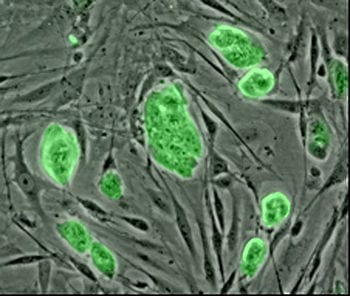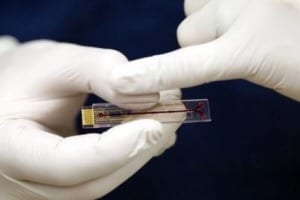
Paves the way for a stem cell bank of cord-blood derived iPSCs to advance regenerative medicine research
Investigators at Johns Hopkins report they have developed human induced-pluripotent stem cells (iPSCs) capable of repairing damaged retinal vascular tissue in mice. The stem cells, derived from human umbilical cord-blood and coaxed into an embryonic-like state, were grown without the conventional use of viruses, which can mutate genes and initiate cancers, according to the scientists. Their safer method of growing the cells has drawn increased support among scientists, they say, and paves the way for a stem cell bank of cord-blood derived iPSCs to advance regenerative medicine research.
In a report published Jan. 20 in the journal Circulation, stem cell biologist Elias Zambidis, M.D., Ph.D., and his colleagues describe laboratory experiments with these non-viral, human retinal iPSCs, created using the virus-free method Zambidis first reported in 2011.
“We began with stem cells taken from cord-blood, which have fewer acquired mutations and little, if any, epigenetic memory, which cells accumulate as time goes on,” says Zambidis, associate professor of oncology and pediatrics at the Johns Hopkins Institute for Cell Engineering and the Kimmel Cancer Center. The scientists converted these cells to a status last experienced when they were part of six-day-old embryos.
Instead of using viruses to deliver a gene package to the cells to turn on processes that convert the cells back to stem cell states, Zambidis and his team used plasmids, rings of DNA that replicate briefly inside cells and then degrade.
Next, the scientists identified high-quality, multipotent, vascular stem cells generated from these iPSC that can make a type of blood vessel-rich tissue necessary for repairing retinal and other human material. They identified these cells by looking for cell surface proteins called CD31 and CD146. Zambidis says that they were able to create twice as many well-functioning vascular stem cells as compared with iPSCs made with other methods, and, “more importantly these cells engrafted and integrated into functioning blood vessels in damaged mouse retina.”
Working with Gerard Lutty, Ph.D., and his team at Johns Hopkins’ Wilmer Eye Institute, Zambidis’ team injected the newly derived iPSCs into mice with damaged retinas, the light-sensitive part of the eyeball. Injections were given in the eye, the sinus cavity near the eye or into a tail vein. When the scientists took images of the mice retinas, they found that the iPSCs, regardless of injection location, engrafted and repaired blood vessel structures in the retina.
“The blood vessels enlarged like a balloon in each of the locations where the iPSCs engrafted,” says Zambidis. The scientists said their cord blood-derived iPSCs compared very well with the ability of human embryonic-derived iPSCs to repair retinal damage.
Zambidis says there are plans to conduct additional experiments of their cells in diabetic rats, whose conditions more closely resemble human vascular damage to the retina than the mouse model used for the current study, he says.
With mounting requests from other laboratories, Zambidis says he frequently shares his cord blood-derived iPSC with other scientists. “The popular belief that iPSCs therapies need to be specific to individual patients may not be the case,” says Zambidis. He points to recent success of partially matched bone marrow transplants in humans, shown to be equally as effective as fully matched transplants.
“Support is growing for building a large bank of iPSCs that scientists around the world can access,” says Zambidis, although large resources and intense quality- control would be needed for such a feat. However, Japanese scientists led by stem-cell pioneer Shinya Yamanaka are doing exactly that, he says, creating a bank of stem cells derived from cord-blood samples from Japanese blood banks.
The Latest on: Virus-Free Stem Cells
[google_news title=”” keyword=”Virus-Free Stem Cells” num_posts=”10″ blurb_length=”0″ show_thumb=”left”]
via Google News
The Latest on: Virus-Free Stem Cells
- How HIV drugs have changed over the decadeson May 7, 2024 at 2:01 am
From one big pill that only prolonged lives a few months, through the 20 pills a day years to modern combination therapies, treating HIV is a science success story ...
- Pluripotent stem cells articles from across Nature Portfolioon May 2, 2024 at 5:00 pm
Pluripotent stem cells are cells that have the capacity to self-renew by dividing and to develop into the three primary germ cell layers of the early embryo and therefore into all cells of the ...
- Study uncovers the secret of long-lived stem cellson April 30, 2024 at 1:20 pm
Nothing lives forever, but compared to other cells in the body, hematopoietic stem cells (HSCs) are remarkably long-lived. HSCs are blood-forming cells—they give rise to rapidly dividing progenitor ...
- Stem Cells Newson April 29, 2024 at 5:00 pm
The Future of Canine Stem Cell Therapy: Unprecedented, Painless, and Feeder-Free Dec. 21, 2023 — Scientists have developed an efficient, non-invasive, and pain-free method to generate canine ...
- Depleting Stem Cells Improves Immunityon April 11, 2024 at 8:00 am
Stem cells are self-renewing cells in the body with the ability to differentiate into any cell type. The outcome to which final cell type it turns into is dependent on what the body needs. Regarding ...
- Could novel immune cell therapy combat hepatitis B infections?on April 9, 2024 at 5:00 pm
and eradication of the virus remains a formidable challenge. However, new research in FEBS Letters indicates that treatment that boosts the effects of immune cells called stem cell memory T cells ...
- Stem cellson March 14, 2024 at 5:00 pm
Oti was diagnosed with leukaemia but is now cancer-free after stem cells were found to be a match. All of John O'Connor's family were tested as potential stem cell donors, but none were a match.
- Inside the Coronaviruson February 3, 2024 at 9:56 am
Next, It Slips Inside This releases fusion machinery, part of the spike's stem that is compressed in a springlike state. The virus and lung-cell membranes fuse. Spike decapitation allows the ...
- Chikungunya Viruson December 18, 2020 at 6:52 am
The researchers used a model system that consisted of mice naturally born without their own immune system, but which had received human stem cells which could then ... To test this idea, virus-free ...
- Zika Viruson December 18, 2020 at 6:52 am
The results indicated that Zika virus can infect prostate stromal mesenchymal stem cells, epithelial cells ... To test this idea, virus-free mosquitoes were allowed to feed on the humanized mice, and ...
via Bing News










